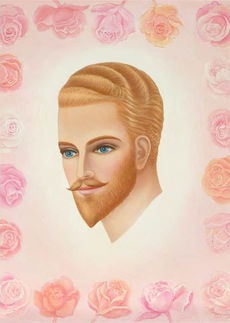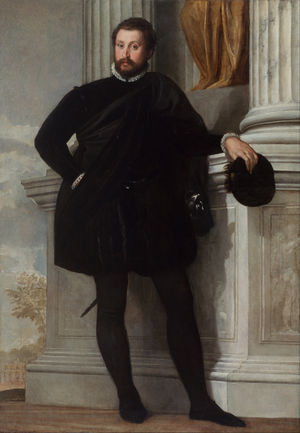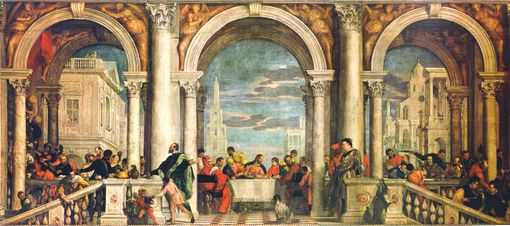Paulo Veneziano

Paulo Veneziano é o chohan do terceiro raio do amor divino e o hierarca do Château de Liberté, retiro que mantém no plano etérico, no sul da França, sobre o rio Ródano.
Paulo patrocina a cultura dos mestres ascensos para esta era e trabalha com todos os que desejam manifestá-la em prol da humanidade. A cultura dos mestres ascensos é a pedra angular da pirâmide da era de ouro; pois eles disseram que é por meio da cultura que a humanidade responderá às verdades espirituais e aos ensinamentos da Grande Fraternidade Branca.
Encarnações
Chefe dos assuntos culturais na Atlântida
Nos tempos da Atlântida, Paulo serviu no governo como chefe de assuntos culturais. Antes de o continente afundar, estabeleceu um foco da chama da liberdade no Peru, que deu impulso à cultura, à beleza e à opulência da civilização inca.
Artista na civilização Inca
Ele encarnou no império inca como um artista que usava tintas que nunca desbotavam (mestria que recuperou na sua encarnação final). A civilização inca floresceu graças ao extraordinário momentum que ele acumulara.
Mestre da arquitetura no Egito
Mais tarde, ele encarnou no Egito como um mestre da arquitetura esotérica, e trabalhou de perto com El Morya, que era nessa altura um mestre pedreiro, durante a construção das pirâmides.

Paolo Veronese
► Artígo principal: [[Special:MyLanguage/Paolo Veronese|{{{2}}}]]
Na sua encarnação final, como Paolo Veronese, foi um dos grandes artistas da escola veneziana do século dezesseis. Nascido Paolo Cagliari, em Verona, Itália, em 1528, o treinamento precoce rendeu-lhe, ainda em tenra idade, renome como pintor talentoso. Aos vinte e cinco anos, foi recebido em Veneza como um mestre da sua arte. O esplendor suntuoso da cidade, as pérolas e as sedas trazidas do Oriente, as suas tapeçarias e brocados elegantes enriqueceram o trabalho do artista, que atingiu o auge da excelência decorativa.
Muito rapidamente as criações de Veronese levaram-no a fazer experimentos surpreendentes com novas cores. Na busca da beleza, libertou-se dos tons castanhos e dos cinzas sombrios dos seus predecessores e adotou a luz vibrante, tornando iridescentes e quase transparentes as suas já graciosas figuras. Desenvolveu tons pastéis luminosos de azul-celeste, coral, pérola, lilás e amarelo-limão que surpreendiam e fascinavam os seus patronos. Paulo adorava as cores fortes e audaciosamente contrastantes, e combinava tonalidades que nunca haviam sido usadas antes: rubi com um verde vívido e aveludado, rosa com esmeralda, água-marinha com violeta.
Como se quisesse ressaltar que a verdadeira beleza dura para sempre, Veronese pesquisou e descobriu uma técnica de preparação de pigmentos que é imbatível no que tange à preservação da pintura. As cores magníficas que criou conservam o brilho até hoje, se comparadas ao teto desbotado da Capela Sistina e aos afrescos de Tiepolo, que estão se deteriorando, embora tenham sido pintados dois séculos mais tarde.
Veronese foi um revolucionário espiritual que combateu as forças anti-vida nas artes. Ele via a beleza como o mais poderoso catalisador da iluminação e dotou de expressões vivas as imagens de Jesus, dos apóstolos e dos santos. Ao associá-las a lugares e coisas facilmente identificáveis, colocou-as ao alcance das pessoas comuns. O mestre transcendeu os tradicionalmente monótonos, inanimados e severos aspectos da arte medieval. As cenas bíblicas, os temas históricos, os festejos e as alegorias que pintou foram executados com alegria e magnificência arrebatadoras.
Paulo ilustrou as etapas das iniciações na senda da Cristicidade e foi prolífico a pintar o martírio dos santos. O seu trabalho mais impressionante é a grande tela Bodas em Caná, que se encontra no museu do Louvre, em Paris, na França. Também são de sua autoria a Tentação de Santo Antônio, A Coroação da Virgem, A Descida da Cruz, A Ceia em Emaús, A Sagrada Família e A Ressurreição de Lázaro, cada uma representando uma importante iniciação da Cristicidade.

Em certa ocasião, Paulo foi convocado pelo Tribunal da Inquisição por suspeita de heresia pelas “irreverências” no seu quadro A Última Ceia, que incluía um anão, um papagaio, guardas com armaduras germânicas, cachorros e um bufão. Veronese defendeu veementemente o direito de liberdade de imaginação para o artista. O Tribunal encontrou uma solução sugerindo que a pintura fosse rebatizada como Festa na Casa de Levi.
Em 1588, Paulo contraiu uma febre e morreu dias depois, em 09 de abril. Os filhos e o irmão enterraram-no em S. Sebastiano, e um busto foi colocado sobre o túmulo. Paulo ascendeu do Château de Liberté, em 19 de abril de 1588.
No Château, antes da sua ascensão, o mestre iniciou o seu trabalho mais grandioso, conhecido como “A Santíssima Trindade”. O Pai Celestial é retratado como uma figura majestosa, uma imagem semelhante a Jesus representa o Filho e uma pomba branca impressionante, cuja envergadura beira os três metros, simboliza o Espírito Santo. A tela distingue-se por transmitir as vibrações das duas dimensões em que Paolo tinha muito interesse, a terrena e a celestial, uma vez que o quadro foi terminado após a sua ascensão. Na parte inferior da obra, Paulo escreveu em letras douradas: “O Amor Perfeito Expulsa o Medo”.
Sua missão hoje
Paulo Veneziano foi um ser majestoso com cerca de dois metros de altura, uma bela aparência, olhos azuis profundos e cabelos louros e ondulados. Geralmente, vestia trajes feitos de veludo verde-esmeralda. Por ser originário do planeta Vênus, onde os habitantes são mestres da Chama e, portanto, irradiam harmonia e amor divinos, a herança natural de Paulo é a beleza e a graça, a diplomacia e o tato. Paulo tem uma voz melodiosa e suave que consola e transmite paz a todos que entram em contato com a sua Presença.
The ascended master Paul the Venetian is a great teacher of the path of love. His devotion is to beauty, the perfection of the soul through compassion, patience, understanding, self-discipline and the development of the intuitive and creative faculties of the heart by the alchemy of self-sacrifice, selflessness and surrender. He initiates the heart chakra, and he trains us in the gift of the discerning of spirits—discerning good and evil, light and shadow and the delicate nuances of all of our creations of beauty. Discernment is a real inner sensitivity to one another.
Retreats
► Main article: Château de Liberté
► Main article: Temple of the Sun
Paul’s retreat, the Château de Liberté, has a physical counterpart in a château now owned by a private French family. At the etheric level, the retreat contains classrooms with paintings and artwork of every kind from all ages and races and cultures, as well as workshops for musicians, writers, sculptors and students of voice. Here the masters introduce new techniques in every field of art.
Currently he is holding classes in the Temple of the Sun, the etheric retreat of the Goddess of Liberty over Manhattan. This is the etheric retreat of Paul’s spiritual Mother, who is the Goddess of Liberty—the cosmic being behind the statue, so named for her complete identification with the God consciousness of liberty. It was she who first enshrined the liberty flame on earth and, just prior to the sinking of Atlantis, transported it from her then-physical Temple of the Sun to the Château de Liberté.
Transfer of the Liberty Flame from his retreat
It was the Goddess of Liberty who inspired the idea of the Statue of Liberty as a gift of the people of France to the people of the United States, which was dedicated on Bedloe’s Island October 28, 1886. A symbol of their friendship and more, it was the spanning of the arc of liberty from the Château de Liberté back to the Temple of the Sun with the intent that the descendants of Atlantis reembodied at both her East and West gates (at France and the United States) would hold high her torch until Liberty’s culture should once again appear in a golden age founded upon the balanced and expanded threefold flame in the hearts of the freedom-loving people of these sister nations.

Seventy-six years later, in a dictation given in Washington, D.C., September 30, 1962, the ascended master K-17 announced the bestowal of another gift from France to America, this time from Paul the Venetian:
There has been held a beautiful and wonderful session at Chananda’s retreat in India, and a decision was made on the part of beloved Paul the Venetian whereby there was transferred from his retreat in France this day, at the hour of eleven o’clock your time, the full pulsation of the great liberty flame.
This flame was permanently placed within the forcefield of the Washington Monument; and the pulsations of the liberty flame are intended to grace the heart of America as a gift from the Brotherhood and from the heart of beloved Paul the Venetian....
It is given as a treasure from the heart of France, from the spiritual government of France to the spiritual government of America.... The liberty flame is a gift of greater magnitude than the former gift of France, the Statue of Liberty, as a tribute to that great being, the Goddess of Liberty. It is incomparable, for the flame itself shall penetrate the structure of the monument, rising high into the atmosphere above it. And all who visit there shall become, even without knowing it, infused by the pulsations of the liberty flame within the heart of America.
Studying with Paul the Venetian

Embodied mankind who serve in the arts attend the retreats of Paul the Venetian for instruction in all of the arts, and through their service, they learn to balance and expand the threefold flame within the heart. Paul explains that the purpose of art is to enhance the love of Christ always.
One who studied at Paul the Venetian’s retreat was Norman Rockwell, American painter and illustrator (1894–1978). Paul speaks of instructing him:
I remember when Norman Rockwell came to me at inner levels to study in my etheric retreat. And I remember as I counseled him to show the Christ in the American people, in everyday scenes of humor, humility, wonder, togetherness, heroism. And all these have been treasured, remembered and valued highly because something of the spirit of the Christ image that is become an image of America came through his work.
A unique artist, one devoted to the inherent qualities and identity of the individual. As his perception of the Christ was, so was his painting the capturing of unique moments. You might examine that work to find in each painting what is the glimmer, however great or faint, of some aspect of the individual reaching for the Higher Self.[1]
The beloved master Paul has promised an important initiation to those who come knocking at the door of his retreat in southern France, ready for a greater increment of the love flame:
I will take you by the hand and show you my castle. I will show you the works of art that have been brought forth by chelas unascended and ascended. And we will go through many rooms, and lastly I will take you to the room where there is that frame that hangs. In some cases it will be an empty frame; in some cases it will have a canvas in it. It will be your frame, the frame of your identity waiting for you to bring forth the genius of your soul. And when you see that frame, if it is empty, you will want to fill it.
And so I will take you to that place, “The Atelier,” where you can work with other artisans who are learning the art of living love by the discipline of the hand and the discipline of expression so that you can draw the image of your own Christ-perfection. And when it is the best that you have to offer, it will be placed in your frame.
And when you come again before that frame after many months of purging and self-purification, you will say undoubtedly, “Beloved Paul, may I have another opportunity to express my Christhood, to draw the image of myself? For I have perceived a new aspect of that image, and I would like to have this, my best offering, now placed in my frame.” And, of course, you will have the opportunity.[2]
The purpose of art
The ascended master Paul the Venetian says:
I AM Paul the Venetian. I paint on canvas on the ethers. I etch in crystal, I sculpt, I mold the clay. I fashion all things physical and many substances not known to you in the higher octaves. To what purpose? To the purpose of showing forth an evermore revealing and exquisite image of the Christ—the Christ appearing in children, in people from every walk of life....
Is it any wonder that we deplore the chaotic and abstract art that has no point of unity? It also portrays a certain barrenness and absence of that point of light in the individual. One can see anarchy by an absence of dimension—an absence of harmony or focalization in modern art.
Modern art enters the subconscious. Accordingly, whether or not the artist is influenced by marijuana or other substances, art portrayed in fabric design, wall coverings, clothing style becomes a matrix capable or incapable of carrying some measure of Christly proportion. When the peoples’ art and sense of art flounders, then the images of Christ recede.
It is rare to find a work of art that is come from the etheric octave in this period.... Where will your leaders learn to deal with the invaders of the minds of the nations? They will learn from the etheric schoolrooms and cities and retreats. How will they get there if they do not contain the crystal that becomes the magnet and a star to follow when the soul goes forth from the body in the hours of sleep?
Unless angels and devotees of light accompany them, they will have no new idea, no means of resolution. Without internal harmony that is the direct child of perfect love, there is no resolution to international terror or the threat of nuclear war. And while abortion itself seems to me the supreme act of anti-art, it does beget the callousness that year-by-year has a lessening sensitivity to the art of angels and the art of God who fashioned the perfect image out of which you were sculpted in clay.
Thus, beloved ones, it is necessary in the very midst of the most tense international circumstances to retreat into the contemplation of the divine beauty and the music of the spheres, to remember that the building blocks of creation are sound and that sound forms a pattern that is a divine harmony and that this divine harmony can be portrayed in architecture, in life, in everyday utensils such as pottery. The things you use and you surround yourself with become a focus for the flow of attention.
Art is not a subject so often dwelt upon in our discourses, for there are such pressing needs—pressing needs of the hour for the victory for Saint Germain. I bring my ingredient of love in this hour as an offering to the Christ Child, to the one and the beloved whom I have so longed to paint in the ultimate sense and have done so to the best of my ability in the etheric octave.[3]
His twin flame
Paul the Venetian’s twin flame is the ascended lady master Ruth Hawkins, the Goddess of Beauty. She ascended in 1995 at the age of eighty-eight and serves with him at the Temple of the Sun.
You may pray to Paul the Venetian to assist you in developing your heart chakra and the threefold flame of the heart and to bring forth the image of the Christ consciousness in your life. Ask him to sponsor the true art of the Aquarian age and to overshadow artists of all kinds in bringing forth the consciousness of the Christ.
Paul the Venetian’s keynote is “I Love You Truly,” by Carrie Jacobs-Bond.
See also
For more information
For more information about the teachings of Paul the Venetian, see the chapters about him in Mark L. Prophet and Elizabeth Clare Prophet, Lords of the Seven Rays.
Sources
Mark L. Prophet and Elizabeth Clare Prophet, The Masters and Their Retreats, s.v. “Paul the Venetian.”
- ↑ Paul the Venetian, “The Art of Love,” Pearls of Wisdom, vol. 27, no. 3, January 15, 1984.
- ↑ Mark L. Prophet and Elizabeth Clare Prophet, Lords of the Seven Rays, book 2, pp. 112–13.
- ↑ Paul the Venetian, “The Art of Love,” Pearls of Wisdom, vol. 27, no. 3, January 15, 1984.
